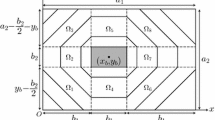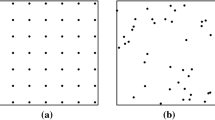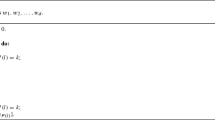Abstract
This paper derives analytical expressions for the rectilinear distance to a facility in the presence of a square barrier. The distribution of the barrier distance is derived for two regular patterns of facilities: square and diamond lattices. This distribution, which provides all the information about the barrier distance, will be useful for facility location problems with barriers and reliability analysis of facility location. The distribution of the barrier distance demonstrates how the location and the size of the barrier affect the barrier distance. A numerical example shows that the total barrier distance increases as the barrier gets closer to a facility, whereas the maximum barrier distance increases as the barrier becomes greater in size.












Similar content being viewed by others
References
Aneja, Y., & Parlar, M. (1994). Algorithms for Weber facility location in the presence of forbidden regions and/or barriers to travel. Transportation Science, 28, 70–76.
Batta, R., Ghose, A., & Palekar, U. (1989). Locating facilities on the Manhattan metric with arbitrarily shaped barriers and convex forbidden regions. Transportation Science, 23, 26–36.
Bell, M., & Iida, Y. (2003). The network reliability of transport. Oxford: Pergamon.
Bischoff, M., & Klamroth, K. (2007). An efficient solution method for Weber problems with barriers based on genetic algorithms. European Journal of Operational Research, 177, 22–41.
Bischoff, M., Fleischmann, T., & Klamroth, K. (2009). The multi-facility location-allocation problem with polyhedral barriers. Computers & Operations Research, 36, 1376–1392.
Butt, S., & Cavalier, T. (1996). An efficient algorithm for facility location in the presence of forbidden regions. European Journal of Operational Research, 90, 56–70.
Canbolat, M., & Wesolowsky, G. (2010). The rectilinear distance Weber problem in the presence of a probabilistic line barrier. European Journal of Operational Research, 202, 114–121.
Dearing, P., Hamacher, H., & Klamroth, K. (2002). Dominating sets for rectilinear center location problems with polyhedral barriers. Naval Research Logistics, 49, 647–665.
Dearing, P., Klamroth, K., & Segars, R. Jr. (2005). Planar location problems with block distance and barriers. Annals of Operations Research, 136, 117–143.
Dearing, P., & Segars, R. Jr. (2002a). An equivalence result for single facility planar location problems with rectilinear distance and barriers. Annals of Operations Research, 111, 89–110.
Dearing, P., & Segars, R. bsuffixJr. (2002b). Solving rectilinear planar location problems with barriers by a polynomial partitioning. Annals of Operations Research, 111, 111–133.
Frieß, L., Klamroth, K., & Sprau, M. (2005). A wavefront approach to center location problems with barriers. Annals of Operations Research, 136, 35–48.
Hamacher, H., & Klamroth, K. (2000). Planar Weber location problems with barriers and block norms. Annals of Operations Research, 96, 191–208.
Katz, I., & Cooper, L. (1981). Facility location in the presence of forbidden regions, I: Formulation and the case of Euclidean distance with one forbidden circle. European Journal of Operational Research, 6, 166–173.
Klamroth, K. (2001a). Planar Weber location problems with line barriers. Optimization, 49, 517–527.
Klamroth, K. (2001b). A reduction result for location problems with polyhedral barriers. European Journal of Operational Research, 130, 486–497.
Klamroth, K. (2002). Single-facility location problems with barriers. New York: Springer.
Klamroth, K. (2004). Algebraic properties of location problems with one circular barrier. European Journal of Operational Research, 154, 20–35.
Krause, E. (1987). Taxicab geometry: an adventure in non-Euclidean geometry. New York: Dover.
Larson, R., & Li, V. (1981). Finding minimum rectilinear distance paths in the presence of barriers. Networks, 11, 285–304.
Larson, R., & Odoni, A. (1981). Urban operations research. Englewood Cliffs: Prentice-Hall.
Larson, R., & Sadiq, G. (1983). Facility locations with the Manhattan metric in the presence of barriers to travel. Operations Research, 31, 652–669.
McGarvey, R., & Cavalier, T. (2003). A global optimal approach to facility location in the presence of forbidden regions. Computers & Industrial Engineering, 45, 1–15.
Mitchell, J. (1992). l 1 shortest paths among polygonal obstacles in the plane. Algorithmica, 8, 55–88.
Miyagawa, M. (2005). Evaluation of the damage caused by facility closing and road blockades from increase in travel distances. Journal of the City Planning Institute of Japan, 40, 187–192. (In Japanese).
Miyagawa, M. (2008). Analysis of facility location using ordered rectilinear distance in regular point patterns. FORMA, 23, 89–95.
Nandikonda, P., Batta, R., & Nagi, R. (2003). Locating a 1-center on a Manhattan plane with “arbitrarily” shaped barriers. Annals of Operations Research, 123, 157–172.
Sarkar, A., Batta, R., & Nagi, R. (2007). Placing a finite size facility with a center objective on a rectangular plane with barriers. European Journal of Operational Research, 179, 1160–1176.
Savaş, S., Batta, R., & Nagi, R. (2002). Finite-size facility placement in the presence of barriers to rectilinear travel. Operations Research, 50, 1018–1031.
Viegas, J., & Hansen, P. (1985). Finding shortest paths in the plane in the presence of barriers to travel (for any l p -norm). European Journal of Operational Research, 20, 373–381.
Wang, S., Bhadury, J., & Nagi, R. (2002). Supply facility and input/output point locations in the presence of barriers. Computers & Operations Research, 29, 685–699.
Acknowledgements
This work was supported by Grant-in-Aid for Young Scientists (B) (22710140). I am grateful to two anonymous reviewers for helpful comments and suggestions.
Author information
Authors and Affiliations
Corresponding author
Appendix
Appendix
1.1 A.1 Distribution of the shortest distance
Square lattice

where

Diamond lattice

where

1.2 A.2 Distribution of the barrier distance with flexible allocation
Square lattice

where

Diamond lattice

where

1.3 A.3 Distribution of the barrier distance with fixed allocation
Square lattice

where

Diamond lattice

where

Rights and permissions
About this article
Cite this article
Miyagawa, M. Rectilinear distance to a facility in the presence of a square barrier. Ann Oper Res 196, 443–458 (2012). https://doi.org/10.1007/s10479-012-1063-z
Published:
Issue Date:
DOI: https://doi.org/10.1007/s10479-012-1063-z




